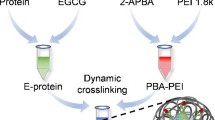ABSTRACT
Purpose
A new approach for non-covalent protein PEGylation is translated from immobilized metal ion affinity chromatography, and based on metal coordination bonds between a chelating agent linked to PEG, nitrilotriacetic acid (NTA), and the ring nitrogen of histidines in a protein.
Methods
PEG-NTA conjugates were synthesized differing in the number of NTA units and in the polymer structure. Three derivatives were investigated in association experiments with five model proteins. The most promising complex, PEG8-(NTA)8–Cu2+–G-CSF (granulocyte colony stimulating factor), was thoroughly characterized and the pharmacokinetic profile was evaluated in rats.
Results
The experiments demonstrated that only PEG8-(NTA)8, bearing eight NTA molecules on flexible PEG arms, associated strongly with those proteins having several histidines. The protein secondary structure was not affected in the complex. PEG8-(NTA)8–Cu2+–G-CSF showed a K D of 4.7 nM, as determined by surface plasmon resonance, but the association was not stable in vivo.
Conclusions
PEG8-(NTA)8 is the first derivative able to associate with native proteins and form soluble complexes with a nanomolar K D. The study highlights the need of a multivalent and flexible coordination and encourages further investigations to increase the stability of PEG8-(NTA)8 complexes in vivo either through the use of protein mutants or His-tag proteins.








Similar content being viewed by others
REFERENCES
Leader B, Baca QJ, Golan DE. Protein therapeutics: a summary and pharmacological classification. Nat Rev Drug Discov. 2008;7:21–39.
Abuchowski A, Mccoy R, Palczuk NC, Van Es T, Davis FF. Effect of covalent attachment of polyethylene glycol on immunogenicity and circulating life of bovine liver catalase. J Biol Chem. 1977;252:3582–6.
Abuchowski A, Van Es T, Palczuk NC, Davis FF. Alteration of immunological properties of bovine serum albumin by covalent attachment of polyethylene glycol. J Biol Chem. 1977;252:3578–81.
Pasut G, Veronese FM. Polymer—drug conjugation, recent achievements and general strategies. Prog Pol Sci. 2005;32:933–61.
Pasut G, Mero A, Caboi F, Scaramuzza S, Sollai L, Veronese FM. A new PEG-beta-alanine active derivative for releasable protein conjugation. Bioconj Chem. 2008;19:2427–31.
Greenwald RB, Yang K, Zhao H, Conover CD, Lee S, Filpula D. Controlled release of proteins from their poly(ethylene glycol) conjugates: drug delivery systems employing 1,6-elimination. Bioconj Chem. 2003;14:395–403.
Zhao H, Yang K, Martinez A, Basu A, Chintala R, Liu HC, et al. Linear and branched bicin linkers for releasable PEGylation of macromolecules: controlled release in vivo and in vitro from mono- and multi-PEGylated proteins. Bioconj Chem. 2006;17:341–51.
Peleg-Shulman T, Tsubery H, Mironchik M, Fridkin M, Schreiber G, Shechter Y. Reversible PEGylation: a novel technology to release native interferon alpha2 over a prolonged time period. J Med Chem. 2004;7:4897–904.
Pasut G, Caboi F, Schrepfer R, Tonon G, Schiavon O, Veronese FM. React Funct Polym. 2007;67:529–39.
Porath J, Carlsson J, Olsson I, Belfrage G. Metal chelate affinity chromatography, a new approach to protein fractionation. Nature. 1975;258:598–9.
Nilsson J, Ståhl S, Lundeberg J, Uhlén M, Nygren P-Å. Affinity fusion strategies for detection, purification, and immobilization of recombinant proteins. Protein Expr Purif. 1997;11:11–6.
Lata S, Gavutis M, Tampe R, Piehler J. Specific and stable fluorescence labeling of histidine-tagged proteins for dissecting multi-protein complex formation. J Am Chem Soc. 2006;128:2365–72.
Goldsmith CR, Jaworski J, Sheng M, Lippard SJ. Selective labeling of extracellular proteins containing polyhistidine sequences by a fluorescein-nitrilotriacetic acid conjugate. J Am Chem Soc. 2006;128:418–9.
Kim SH, Jeyakumar M, Katzenellenbogen JA. Dual-mode fluorophore-doped nickel nitrilotriacetic acid-modified silica nanoparticles combine histidine-tagged protein purification with site-specific fluorophore labeling. J Am Chem Soc. 2007;129:13254–64.
Cheng F, Gamble LJ, Castner DG. XPS, TOF-SIMS, NEXAFS, and SPR characterization of nitrilotriacetic acid-terminated self-assembled monolayers for controllable immobilization of proteins. Anal Chem. 2008;80:2564–73.
Lata S, Reichel A, Brock R, Tampe R, Piehler J. High-affinity adaptors for switchable recognition of histidine-tagged proteins. J Am Chem Soc. 2005;127:10205–15.
Van Broekhoven CL, Altin JG. The novel chelator lipid 3(nitrilotriacetic acid)-ditetradecylamine (NTA(3)-DTDA) promotes stable binding of His-tagged proteins to liposomal membranes: potent anti-tumor responses induced by simultaneously targeting antigen, cytokine and costimulatory signals to T cells. Biochim Biophys Acta. 2005;1716:104–16.
Huang ZH, Park JI, Watson DS, Hwang P, Szoka FC. Facile synthesis of multivalent nitrilotriacetic acid (NTA) and NTA conjugates for analytical and drug delivery applications. Bioconj Chem. 2006;17:1592–600.
Huang Z, Hwang P, Watson DS, Cao Jr L. Tris-nitrilotriacetic acids of subnanomolar affinity toward hexahistidine tagged molecules. Bioconjug Chem. 2009;20:1667–72.
Platt V, Huang Z, Cao L, Tiffany M, Riviere K, Szoka Jr FC. Influence of multivalent nitrilotriacetic acid lipid-ligand affinity on the circulation half-life in mice of a liposome-attached His6-protein. Bioconjug Chem. 2010;21:892–902.
Sablin EP, Woods A, Krylova IN, Hwang P, Ingraham HA, Fletterick RJ. The structure of corepressor Dax-1 bound to its target nuclear receptor LRH-1. Proc Natl Acad Sci USA. 2008;105:18390–5.
Guideline on the specification limits for residues of metal catalysts or metal reagents (2008) Committee for medicinal products for human use. London, 21 February 2008. Doc. Ref. EMEA/CHMP/SWP/4446/2000.Available from: www.ema.europa.eu/pdfs/human/swp/444600enfin.pdf
Snyder SL, Sobocinski PZ. An improved 2,4,6-trinitrobenzenesulfonic acid method for the determination of amines. Anal Biochem. 1975;64:284–8.
Pasut G, Scaramuzza S, Schiavon O, Mendichi R, Veronese FM. PEG-epirubicin conjugates with high drug loading. J Bioac Comp Pol. 2005;20:213–30.
Porath J, Olin B. Immobilized metal ion affinity adsorption and immobilized metal ion affinity chromatography of biomaterials. Serum protein affinities for gel-immobilized iron and nickel ions. Biochemistry. 1983;22:1621–30.
Knecht S, Ricklin D, Eberle AN, Ernst B. Oligohis-tags: mechanisms of binding to Ni2+−NTA surfaces. J Mol Recognit. 2009;22:270–9.
Ishino T, Pillalamarri U, Panarello D, Bhattacharya M, Urbina C, Horvat S, et al. Asymmetric usage of antagonist charged residues drives interleukin-5 receptor recruitment but is insufficient for receptor activation. Biochemistry. 2006;45:1106–15.
ACKNOWLEDGMENTS
The authors were supported in part by MIUR project CPDA085841 and BioKer srl (IT).
Author information
Authors and Affiliations
Corresponding author
Rights and permissions
About this article
Cite this article
Mero, A., Ishino, T., Chaiken, I. et al. Multivalent and Flexible PEG-Nitrilotriacetic Acid Derivatives for Non-covalent Protein Pegylation. Pharm Res 28, 2412–2421 (2011). https://doi.org/10.1007/s11095-011-0468-8
Received:
Accepted:
Published:
Issue Date:
DOI: https://doi.org/10.1007/s11095-011-0468-8




